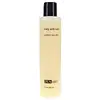What's inside
What's inside
 Key Ingredients
Key Ingredients

 Benefits
Benefits

 Concerns
Concerns

 Ingredients Side-by-side
Ingredients Side-by-side

Water
Skin ConditioningSodium C14-16 Olefin Sulfonate
CleansingPropanediol
SolventCellulose Acetate
Caprylyl/Capryl Glucoside
CleansingAcrylates Copolymer
Coco-Glucoside
CleansingGlyceryl Oleate
EmollientSodium Cocoamphoacetate
CleansingGlycerin
HumectantAloe Barbadensis Leaf Juice
Skin ConditioningCaprylic/Capric Triglyceride
MaskingBenzyl Alcohol
PerfumingCocamidopropyl Hydroxysultaine
CleansingEthylhexylglycerin
Skin ConditioningBisabolol
MaskingHydrolyzed Jojoba Esters
Skin ConditioningSclerotium Gum
Emulsion StabilisingSodium Hydroxide
BufferingRosmarinus Officinalis Leaf Oil
MaskingSalicornia Herbacea Extract
Skin ConditioningTetrasodium EDTA
Lavandula Angustifolia Oil
MaskingCamellia Oleifera Leaf Extract
AstringentAvena Sativa Kernel Extract
AbrasiveWater, Sodium C14-16 Olefin Sulfonate, Propanediol, Cellulose Acetate, Caprylyl/Capryl Glucoside, Acrylates Copolymer, Coco-Glucoside, Glyceryl Oleate, Sodium Cocoamphoacetate, Glycerin, Aloe Barbadensis Leaf Juice, Caprylic/Capric Triglyceride, Benzyl Alcohol, Cocamidopropyl Hydroxysultaine, Ethylhexylglycerin, Bisabolol, Hydrolyzed Jojoba Esters, Sclerotium Gum, Sodium Hydroxide, Rosmarinus Officinalis Leaf Oil, Salicornia Herbacea Extract, Tetrasodium EDTA, Lavandula Angustifolia Oil, Camellia Oleifera Leaf Extract, Avena Sativa Kernel Extract
Water
Skin ConditioningAloe Barbadensis Leaf Juice
Skin ConditioningGlycolic Acid
BufferingLactic Acid
BufferingGluconolactone
Skin ConditioningSalicylic Acid
MaskingNiacinamide
SmoothingBetaine
HumectantHibiscus Sabdariffa Flower Extract
Skin ConditioningTerminalia Ferdinandiana Fruit Extract
AntioxidantSodium Hyaluronate
HumectantCaprylic/Capric Triglyceride
MaskingCitrus Aurantium Dulcis Peel Extract
Emulsion StabilisingVanilla Planifolia Fruit Extract
Skin ConditioningCitrus Tangerina Peel Extract
AstringentDimethyl Isosorbide
SolventEvodia Rutaecarpa Fruit Extract
Skin ConditioningPropanediol
SolventSorbitan Oleate Decylglucoside Crosspolymer
CleansingSodium PCA
HumectantSodium Hydroxide
BufferingSodium Benzoate
MaskingWater, Aloe Barbadensis Leaf Juice, Glycolic Acid, Lactic Acid, Gluconolactone, Salicylic Acid, Niacinamide, Betaine, Hibiscus Sabdariffa Flower Extract, Terminalia Ferdinandiana Fruit Extract, Sodium Hyaluronate, Caprylic/Capric Triglyceride, Citrus Aurantium Dulcis Peel Extract, Vanilla Planifolia Fruit Extract, Citrus Tangerina Peel Extract, Dimethyl Isosorbide, Evodia Rutaecarpa Fruit Extract, Propanediol, Sorbitan Oleate Decylglucoside Crosspolymer, Sodium PCA, Sodium Hydroxide, Sodium Benzoate
Ingredients Explained
These ingredients are found in both products.
Ingredients higher up in an ingredient list are typically present in a larger amount.
Aloe Barbadensis Leaf Juice comes from leaves of the aloe plant. Aloe Barbadensis Leaf Juice is best known for helping to soothe sunburns. It is also anti-inflammatory, moisturizing, antiseptic, and can help heal wounds.
Aloe is packed with good stuff including Vitamins A, C, and E. These vitamins are antioxidants, which help fight free-radicals and the damage they may cause. Free-radicals are molecules that may damage your skin cells, such as pollution.
Aloe Barbadensis Leaf Juice also contains sugars. These sugars come in the form of monosaccharides and polysaccharides, folic acid, and choline. These sugars are able to help bind moisture to skin.
It also contains minerals such as calcium, 12 anthraquinones, fatty acids, amino acids, and Vitamin B12.
Learn more about Aloe Barbadensis Leaf JuiceThis ingredient is an emollient, solvent, and texture enhancer. It is considered a skin-softener by helping the skin prevent moisture loss.
It helps thicken a product's formula and makes it easier to spread by dissolving clumping compounds.
Caprylic Triglyceride is made by combining glycerin with coconut oil, forming a clear liquid.
While there is an assumption Caprylic Triglyceride can clog pores due to it being derived from coconut oil, there is no research supporting this.
Learn more about Caprylic/Capric TriglyceridePropanediol is an all-star ingredient. It softens, hydrates, and smooths the skin.
It’s often used to:
Propanediol is not likely to cause sensitivity and considered safe to use. It is derived from corn or petroleum with a clear color and no scent.
Learn more about PropanediolSodium Hydroxide is also known as lye or caustic soda. It is used to adjust the pH of products; many ingredients require a specific pH to be effective.
In small amounts, sodium hydroxide is considered safe to use. However, large amounts may cause chemical burns due to its high alkaline.
Your skin has a natural pH and acid mantle. This acid mantle helps prevent harmful bacteria from breaking through. The acid mantle also helps keep your skin hydrated.
"Alkaline" refers to a high pH level. A low pH level would be considered acidic.
Learn more about Sodium HydroxideWater. It's the most common cosmetic ingredient of all. You'll usually see it at the top of ingredient lists, meaning that it makes up the largest part of the product.
So why is it so popular? Water most often acts as a solvent - this means that it helps dissolve other ingredients into the formulation.
You'll also recognize water as that liquid we all need to stay alive. If you see this, drink a glass of water. Stay hydrated!
Learn more about Water